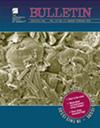华北克拉通南部松山地区中低品位变质复合体中长期古新生代变质过程的制约因素:微量元素测温和地质年代学的证据
IF 3.9
1区 地球科学
Q1 GEOSCIENCES, MULTIDISCIPLINARY
引用次数: 0
摘要
登封复合体和嵩山组是嵩山地区(中国河南中部)的中低级变质复合体,具有丰富的岩性关联,是研究华北克拉通热历史的绝佳机会。多变质的登封复合带是一个典型的花岗岩-绿岩带,它记录了一个晚古生代变质事件(约 1.95-1.80 Ga)叠加一个晚新元古代变质事件(约 2.51-2.41 Ga)。相比之下,松山组则保留了发育良好的地层序列和沉积构造,并具有绿泥石派变质作用。大量研究集中于登封群新元古代晚期的变质事件,而登封群和松山组约1.95-1.80 Ga单元的热演化却在很大程度上被忽视了。松山组的石英岩不整合地覆于登封组的片岩之上,它们呈现出一致的NNE-SSW走向的片状构造,倾角在50°-65°之间。在这里,登封组的变质温度被Ti-in-biotite地温仪推定为∼510-550 °C。松山组的石英中钛和金红石中锌地温度计记录的变质温度分别为480-550 °C或520-555 °C。激光烧蚀-电感耦合等离子体-质谱法对独居石和金红石的U-Pb年代测定,将松山组的变质时间推定为约1.94-1.83 Ga。1.94-1.83Ga,而锆石则将登封群的变质时间推定为约2.53Ga和约1.83Ga。2.53Ga和约1.95-1.87Ga。通过整合登封岩群和松山组的地质年代数据,可推算出登封岩群的变质时间约为2.53 Ga,松山组的变质时间约为1.95-1.87 Ga。而本研究获得的1.95-1.83 Ga的一致温度则表明,松山地区可能经历过一次长时期的变质事件,这可能是古近代晚期华北克拉通西块和东块最终碰撞的结果。古生代热造山持续数百万年可能是华北克拉通的常态,这为华北克拉通南部的构造-热演化提供了新的见解。本文章由计算机程序翻译,如有差异,请以英文原文为准。
Constraints on a long-lived Paleoproterozoic metamorphic process in a middle- to lower-grade metamorphic complex, Songshan area, southern North China craton: Evidence from minor- and trace-element thermometry and geochronology
The Dengfeng Complex and Songshan Group comprise a middle- to lower-grade metamorphic complex with abundant lithological associations in the Songshan area (central Henan, China), representing an excellent opportunity to investigate the thermal history of the North China craton. The polymetamorphic Dengfeng Complex is a typical granite-greenstone belt that records a late Paleoproterozoic metamorphic event (ca. 1.95−1.80 Ga) overprinting on a late Neoarchean metamorphic event (ca. 2.51−2.41 Ga). In contrast, the Songshan Group preserves well-developed stratigraphic sequences and sedimentary structures with greenschist-facies metamorphism. Numerous studies have focused on the late Neoarchean metamorphic event from the Dengfeng Complex, whereas the thermal evolution of ca. 1.95−1.80 Ga units from the Dengfeng Complex and Songshan Group has been largely overlooked. Quartzite of the Songshan Group unconformably overlies schists of the Dengfeng Group, and they show coherent NNE-SSW−striking schistosity structures with dip angles of ∼50°−65°. Here, the metamorphic temperatures from the Dengfeng Group were constrained to be ∼510−550 °C by the Ti-in-biotite geothermometer. The Ti-in-quartz and Zr-in-rutile geothermometers record metamorphic temperatures of ∼480−550 °C or 520−555 °C for the Songshan Group, respectively. Laser ablation−inductively coupled plasma−mass spectrometry U-Pb dating of monazite and rutile constrains the timing of metamorphism of the Songshan Group to be ca. 1.94−1.83 Ga, while zircon constrains the timing of metamorphism of the Dengfeng Complex to be ca. 2.53 Ga and ca. 1.95−1.87 Ga. By integrating geochronologic data from the Dengfeng Complex and Songshan Group, the ca. 2.53 Ga metamorphic age of amphibolite may be connected with Neoarchean subduction-accretion processes, whereas the consistent temperature obtained in this study ca. 1.95−1.83 Ga indicates that the Songshan area may have experienced a long-lived metamorphic event, which could have resulted from the final collision between the Western and Eastern blocks of the North China craton in the late Paleoproterozoic. The persistence of a Paleoproterozoic hot orogen for millions of years was probably the norm in the North China craton, which provides new insights into the tectonic-thermal evolution in the southern North China craton.
求助全文
通过发布文献求助,成功后即可免费获取论文全文。
去求助
来源期刊

Geological Society of America Bulletin
地学-地球科学综合
CiteScore
9.30
自引率
8.20%
发文量
159
审稿时长
4-8 weeks
期刊介绍:
The GSA Bulletin is the Society''s premier scholarly journal, published continuously since 1890. Its first editor was William John (WJ) McGee, who was responsible for establishing much of its original style and format. Fully refereed, each bimonthly issue includes 16-20 papers focusing on the most definitive, timely, and classic-style research in all earth-science disciplines. The Bulletin welcomes most contributions that are data-rich, mature studies of broad interest (i.e., of interest to more than one sub-discipline of earth science) and of lasting, archival quality. These include (but are not limited to) studies related to tectonics, structural geology, geochemistry, geophysics, hydrogeology, marine geology, paleoclimatology, planetary geology, quaternary geology/geomorphology, sedimentary geology, stratigraphy, and volcanology. The journal is committed to further developing both the scope of its content and its international profile so that it publishes the most current earth science research that will be of wide interest to geoscientists.
 求助内容:
求助内容: 应助结果提醒方式:
应助结果提醒方式:


